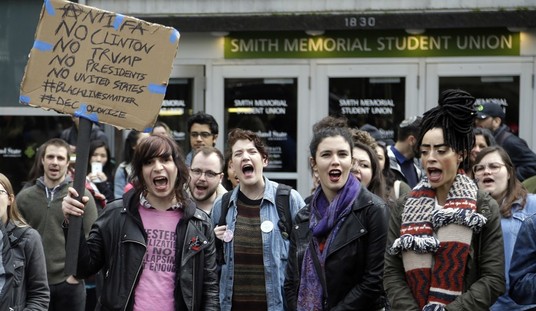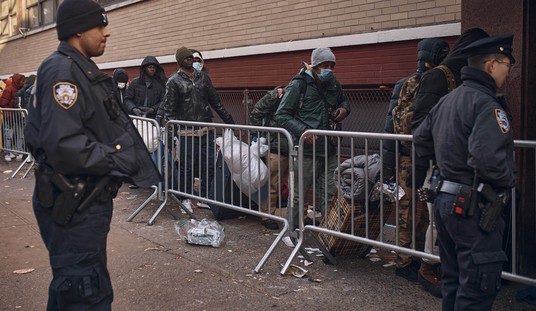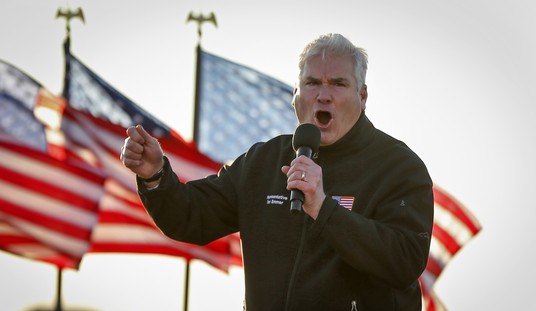Who’s “we,” kemosabe?
The proper response to the question in the clip below is, “Restrictions are above my pay grade. Governors and mayors decide those. I’m a scientist. I’m just here to tell you what the numbers say.”
Although I also would have accepted, “There’s no need for formal restrictions. The surge in cases we’re about to see will be so mind-boggling that all but the least risk-averse people will hunker down at home for awhile voluntarily.”
In fact, as I’m writing this, news is breaking:
Flashing now:
*NEW YORK REPORTS OVER 20,000 COVID-19 CASES, NEW DAILY RECORD— Stephen Merelman (@Smerelman) December 17, 2021
The exact number is 21,027 cases, the first time New York State has officially cracked 20,000 in a day. It’s a cinch that case counts were higher than that in the early days of the pandemic, before testing was available, but give it a week. The way Omicron spreads, they’re likely headed for a true record in daily COVID infections. In fact, if it’s true that the variant’s doubling time is two to three days, New York State could reach 100,000 cases by Christmas Day. The entire United States is averaging “only” 125,000 right now. Watch, then read on.
The UK had upwards of 90,000 cases yesterday and we’re five times their size. A half million cases per day soon seems like a fait accompli. A million a day? Two million? The only limit is lab testing capacity.
One thing that hit me hard this morning even though it’s been obvious since this summer is that the experts no longer have any idea of where this is going. That was clear enough when we got slammed by Delta just as everyone was expecting the pandemic to begin winding down post-vaccination. It became clearer when the reality of waning immunity, something the U.S. public hadn’t been prepared for by the scientific bureaucracy, began to dawn in Israel. But the emergence of Omicron has made me feel more keenly than before the extent to which the experts have no sense of what the future holds. Some researchers have even admitted that they didn’t expect a variant with as many mutations as Omicron to appear for another year or two as the virus evolved across the planet.
Will we face another mutant next winter that’s even more contagious than this one, assuming that’s possible? There’s no reason not to think so. And if Fauci or any of the other public health experts on TV 24/7 conjures up some argument to believe the worst is behind us, remember that they thought that six months ago as well. Now here we stand on the precipice of what looks to be a national wave of viral infection worse than any the country’s experienced since … when? Ever?
The disruptions have already begun without anyone ordering new “restrictions.”
New Week 15 schedule pic.twitter.com/LqwBnrgHE3
— Brian McCarthy (@NFLprguy) December 17, 2021
The @NHL has extended the period of game postponements for the @NHLFlames through Dec. 23.
Additionally, @Avalanche and @FlaPanthers games also will be postponed at least through the scheduled completion of the League's Holiday Break on Dec. 26. https://t.co/uwKuHkEhJw pic.twitter.com/d8r558IcCa
— NHL Public Relations (@PR_NHL) December 17, 2021
I think cancellations and postponements will be par for the course for many schools and businesses through New Year’s, until America has a better sense of what it’s dealing with. If Omicron really is an Omi-cold and hospitalizations don’t rise, they’ll kick back into gear in January and let it rip. If it turns out to be more severe than everyone hoped, who knows where this goes. Not the experts, certainly.
That’s the institutional outlook. The individual outlook, realistically, is that most people won’t cancel Christmas or New Year’s over a new variant which they’ve heard repeatedly is “mild.” This guy will be the exception rather than the rule:
I turn 40 today, and I was planning to have a party. The Delta surge made me nervous about it. The arrival of Omicron made me cancel it…
I know that many of my friends, like many vaccinated Americans, have been going out to restaurants, bars, gyms, and movie theaters. I know that Omicron’s incubation period—the gap between infection and symptoms—seems unusually short, so that even people who tested negative a few days ago might still be infected and infectious. I know that even mild infections can lead to long COVID.
If someone got sick, I know others could too. A week later, many of my friends will spend Christmas with their own families. At best, a cluster of infections at the birthday party would derail those plans, creating days of anxious quarantine or isolation, and forcing the people I love to spend time away from their loved ones. At worst, people might unknowingly carry the virus to their respective families, which might include elderly, immunocompromised, unvaccinated, partially vaccinated, or otherwise vulnerable people. Being born eight days before Christmas creates almost the perfect conditions for one potential super-spreader event to set off many more.
That’s Ed Yong, who recognizes that his personal risk from catching COVID at his party is tiny but the risk that someone there will start a chain of transmission that’ll eventually make its way to a person who’s vulnerable isn’t. That’s the bottom line on socializing during the Omicron wave. Each individual is probably at minimum risk of severe illness, and the younger and more vaccinated they are, the lower the risk is. But literally everyone is a vector of transmission now and capable of infecting several others once they’re contagious. We don’t need state-enforced restrictions to keep people apart if they’re willing to do so voluntarily to try to limit the spread. I wonder how much of the public is willing to do that for their community at this stage of the pandemic. Twenty-five percent, maybe?
I’ll leave you with this tweet from one of the South African experts who first identified Omicron a month ago. We’ve all been celebrating the fact that cases have leveled off and deaths haven’t surged but we might be misreading the data, he says. Gauteng province loses population seasonally every year at this time. The variant may appear to be milder simply because there are fewer people around to test positive or die.
I would like to ask one to be careful on not interpretation of Gauteng data from middle December. The reason is that Gauteng get quite empty and 100,000s of migrant workers and holiday makers leave. Tip, get a look at Beta wave at similar time last year in Gauteng pic.twitter.com/UzBVpMAa2I
— Tulio de Oliveira (@Tuliodna) December 17, 2021








Join the conversation as a VIP Member